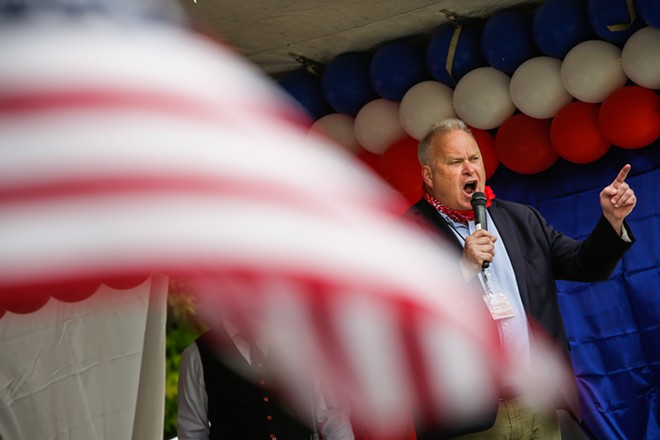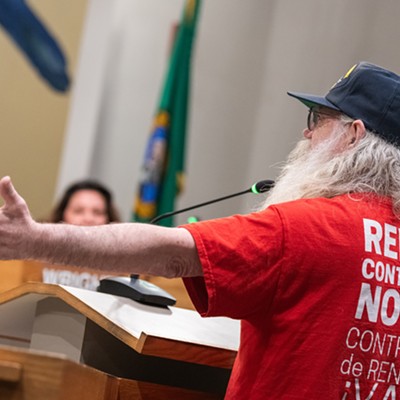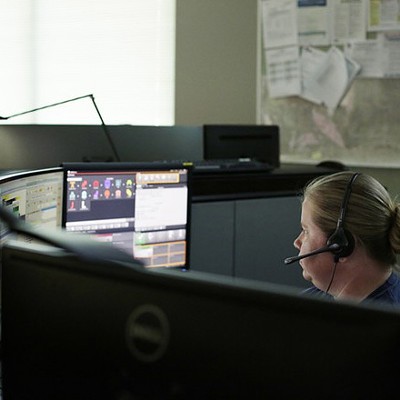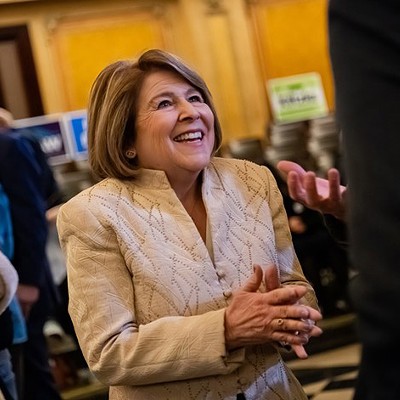
Analysis by Anna V. Smith, High Country News
In the first weeks of June, as protests against police brutality spread across the country, a group of people who were neither demonstrators nor law enforcement began to appear in the streets. These members of the Patriot militia movement — an assortment of groups defined by antigovernment, pro-gun and conspiracy-driven ideologies — watched from the sidelines, kitted out in bulletproof vests and camouflage and armed with semi-automatic rifles.
By mid-June, there had been 136 instances of paramilitary, far-right and armed militia groups or individuals attending anti-police violence protests nationwide, according to Political Research Associates, a social justice think tank. In Coeur d’Alene, Idaho, militia groups and motorcycle clubs gathered in hopes of confronting antifascists who never materialized. In Oakdale, California, rumors of a Black Lives Matter protest drew members of the California State Militia but few others. In Olympia, Washington, members of the Washington State Three Percent guarded businesses, at, they said, the owners’ request, posing for a photo with a police officer. (The police department later launched an investigation into the incident.)
The protests and concurrent pandemic have proven a boon to extremist groups looking to increase their visibility. During the early stages of the coronavirus outbreak, Patriot militia members — particularly those in the Three Percent — mobilized around food drives and “reopen” rallies. Then, as protests against police violence spread, Three Percenters and other Patriot militia groups positioned themselves as guardians of private property and free speech. The leadership vacuum left by state and federal authorities in recent months offered the groups an opening, allowing them to accrue clout, provide services in lieu of government action and build political influence.
“We’ve certainly seen a clear pivot from militia groups active in the so-called reopen protests to, now, armed security in local communities.”
tweet this
“We’ve certainly seen a clear pivot from militia groups active in the so-called reopen protests to, now, armed security in local communities,” said Amy Herzfeld-Copple, deputy director of Western States Center, a politically progressive organization that promotes inclusive democracy. “That has a real chilling effect on democratic practice. We see a throughline from militia groups mobilizing to exploit the pandemic to their military presence in small towns across the West — another opening for them to try and posture as providing a service that we’d normally look to government to provide.”
The Three Percent has been particularly visible in the Western U.S. Founded in 2008, in opposition to President Barack Obama’s administration and its perceived threat to gun rights, the movement takes its name from settler-colonial mythology: the belief that just 3% of people in the 13 British colonies took up arms to fight in the Revolutionary War (a statistic that historians dispute). Members generally describe themselves as defending individual liberty from a tyrannical government. The sprawling and decentralized movement is without a national leadership structure: Some Three Percent groups operate statewide, while others are county-based. And while some have disavowed racism, others are virulently anti-Muslim and anti-immigrant. Because anyone can claim the movement, a variety of activities, from violence to paramilitary training to nonprofit food drives, have been carried out beneath its banner.
Still, several ideological tenets bind Three Percenters together. One is a refusal to obey “unjustified martial law” or a “state of emergency.” So when the novel coronavirus arrived in the United States earlier this year, some members were primed to oppose the policies enacted to curb it. As schools and businesses closed and governors issued stay-at-home orders, rumors of “medical martial law” circulated. Three Percenter Facebook pages roiled, comparing stay-at-home orders to the Holocaust, questioning the legitimacy of local and state public health decisions, predicting civil war and spreading misinformation about COVID-19.
Threats, real or perceived, provided an opportunity for a show of strength by various Patriot militia groups. At the beginning of the pandemic, the Washington State Three Percent — which rejects the antigovernment, militia and extremist labels — delivered truckloads of goods to food banks, coordinated a dozen food drives and organized reopen rallies to address the twin problems of food insecurity and economic fallout, according to Matt Marshall, the group’s founder. Meanwhile, its Facebook posts included threats to contact tracers. As a registered nonprofit, the group is required to “be operated exclusively to promote social welfare.” Marshall — a Republican currently running for the Washington House of Representatives — is on a school board; other members are on city councils and run food banks. “The purpose (of the group) is to prepare, and support the community. And, if the time ever came, defend the community,” said Marshall. “Not taking a militia-type role, but a truly grassroots support role.” Marshall is also a supporter of Washington state Rep. Matt Shea, who, last year, was found to have participated in domestic terrorism by an investigation commissioned by the Legislature.
“Civilians have legal authority to use firearms for self-protection, not vigilante justice.”
tweet this
Patriot militia groups, who generally see themselves as good community members, often use civic engagement to gain local support and new members. After Hurricane Harvey hit Houston in 2017, Oath Keepers mobilized to provide boats, search and rescue operations and medical care. In the Pacific Northwest, there are at least 20 instances of Three Percent and other Patriot militia groups signing up for Adopt-a-Highway, a nationwide program that promises “positive impressions when consumers know that you are doing good for the community.” In May, the Real 3%ers Idaho coordinated the distribution of 15,000 pounds of surplus potatoes donated by a farm in Reardan, Washington, according to The Coeur d’Alene/Post Falls Press. Armed members of the group later showed up in Coeur d’Alene during a protest against police violence.
Washington State Three Percenters also intertwined their pandemic efforts with a political push. In May, the group posted on Facebook asking for volunteers to help with the next food drive, while also collecting signatures for a ballot initiative to repeal Washington’s comprehensive sex education law. (In June, the petition, which was backed by anti-LGBTQ+ groups, gathered enough signatures to get the initiative on the November ballot.) Tying ideological aims to the distribution of essential goods is problematic, Herzfeld-Copple said. “Often, part of their ideology is to replace civil infrastructure. And if they have opportunities to step in and build shadow government infrastructure, it’s not going to serve the interests of the whole community.”
THAT CONCERN IS REFLECTED in Patriot militia groups’ presence at protests as an extrajudicial authority, which they point to as another example of fulfilling a civic duty. At a Black Lives Matter protest in Sandpoint, Idaho, organizers denounced the armed presence of militia members as nothing but intimidation, saying they neither needed nor wanted their protection, according to The Sandpoint Reader.
The mayor of Sandpoint echoed this in a statement: “Civilians have legal authority to use firearms for self-protection, not vigilante justice. It is the job and responsibility of the police to enforce the laws and protect the city from looting or violence.”
In the past, militia groups have directed their ire and conspiracy theories primarily at the federal government, said Mark Pitcavage, a senior research fellow at the Anti-Defamation League’s Center of Extremism, who has been studying the groups since the 1990s. Now, for the first time, they have someone in office to stand behind. President Donald Trump has broad support within the militia movement, so groups have turned to state-level issues, focusing especially on laws limiting access to guns. In 2018, Three Percenters and Oath Keepers campaigned for an ordinance that would allow county sheriffs to disregard gun laws they deemed unconstitutional. (It passed in eight Oregon counties.) This year, Three Percenters in Oregon, Idaho and Washington are running for county commissioner, state representative and sheriff.
Researchers say Patriot militia group leaders are political extremists, who operate as such. “They contribute to a conflictual understanding of politics,” said Sam Jackson, who researches antigovernment extremism at the University at Albany and is the author of an upcoming book on the Oath Keepers, “where there are enemies across the political divide, and we’re in a battle against those enemies, and we need to be prepared to use whatever means necessary against those enemies.”
Watchdogs expect Patriot militia groups to mobilize around this year’s election. It has happened before: In 2016, after candidate Donald Trump falsely claimed voter fraud, Oath Keepers showed up at polling stations. In Portland, Oregon, in 2017, the local Republican Party voted to hire Three Percenters and Oath Keepers to provide event security. This year, amid ongoing waves of the pandemic and with some states halting their reopening, “there is going to be so much distraction and calls for voter suppression by the White House between now and November,” Herzfeld-Copple said. “There are going to be lots of openings for antidemocratic groups to seize.”
This story was originally published at High Country News (hcn.org) on July 27, 2020.

















